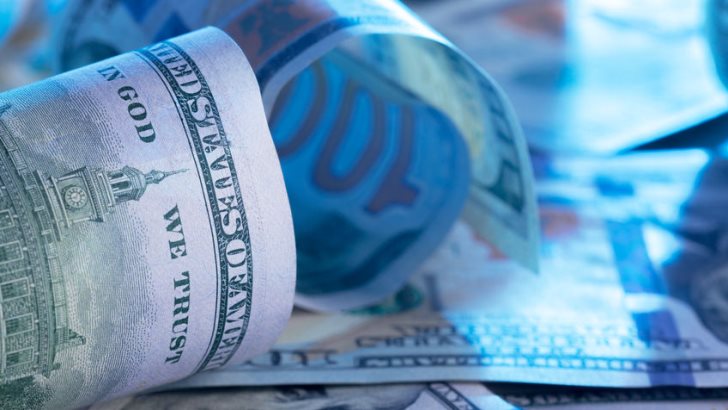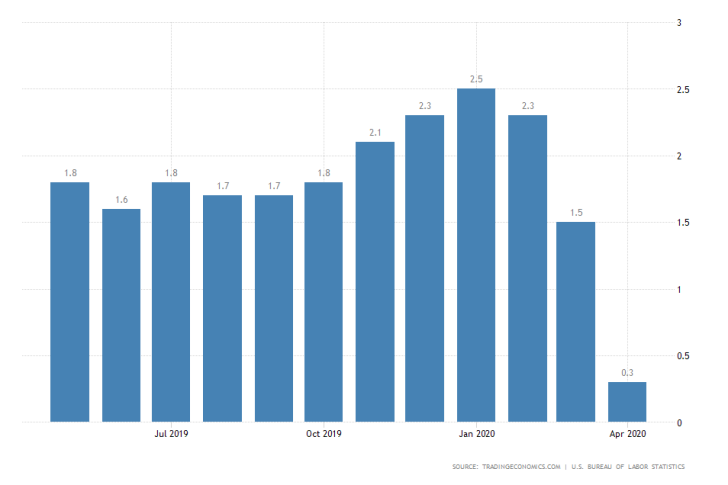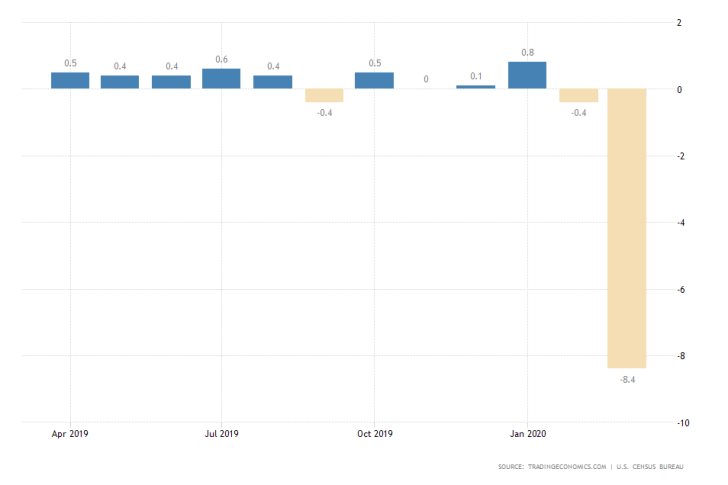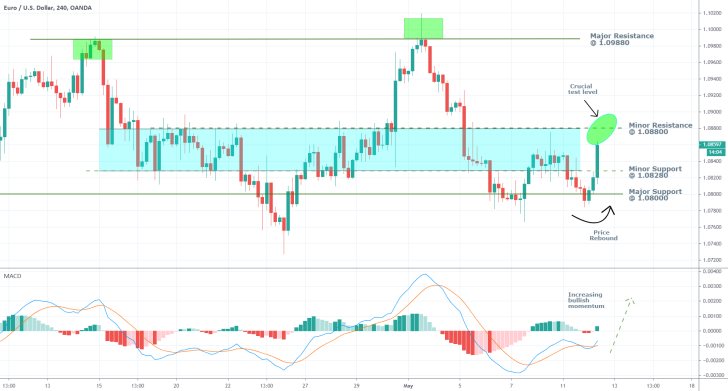
The yearly inflation rate in the US has tumbled by the massive 1.2 per cent in April, which underscores the heavy toll from the coronavirus crisis and the national lockdown that is being exerted on the American consumer.
The findings of the US Bureau of Labor Statistics' economic report missed the consensus forecasts, which anticipated a drop to 0.4 per cent in April. Instead, the overall inflation rate was revised down to 0.3 per cent from the 1.5 per cent that were recorded in March.
The newest inflation data signifies the underlying deterioration in the US price stability, which is caused by severely impeded consumer spending coupled with the unprecedented tumble of oil prices last month.

The extremely low prices of crude oil damaged the utilities and transportation industry, as well as the construction and manufacturing sectors, leading to considerable loss of jobs. This was demonstrated in the last ADP employment report.
Discounting the impact of essential products hoarding by individuals in the wake of the US lockdown, retail sales have been unusually subdued over the last weeks, which is the result of diminished consumer spending.

This, in turn, is affecting the price stability in the country, as people continue to be following the policies of social distancing by staying mostly at home. The consequence of this being the diminished levels of spending within the economic circulation.
Near-negative inflation is a significant concern for the Federal Reserve, which now has to weigh in on the newly downgraded prospects for economic growth.
At its last meeting, the FOMC did not implement any major changes to the underlying monetary policy but expressed commitment to intervene by increasing the scope of its asset-purchasing program if it deems it necessary at a future date.
Given the disquieting recent developments, the FED might be hardpressed to step up on its efforts in order to accommodate the underlying economic activity even more. Increasing the liquidity levels is likely going to alleviate the short-term market pains, but this could subsequently strain the value of the dollar.
Meanwhile, the greenback has depreciated against the Euro by nearly 0.60 per cent so far during today's trading session. The EURUSD is currently on the verge of establishing a new bullish upswing.
As can be seen on the hourly chart below, the pair is about to test the strength of the minor resistance level at 1.08800, while the MACD illustrates the rising bullish momentum in the short run.
If the upswing manages to break out above the resistance, the next logical target would be the major resistance level at 1.09880.

Trendsharks Premium
Gold is undergoing a correction, as investors take profits to offset losses from falling stock prices, impacting their margins. However, we anticipate a renewed wave of [...]
The Swiss stock market index is mirroring its global counterparts, such as Germany 40 and US100, experiencing a sharp decline following the announcement of new [...]
We’re analyzing the weekly chart to grasp the broader market trend. Over the past three years, the US30 index has surged by 17,000 points, often resembling a nearly straight [...]
Over the past week, the DAX has experienced a sharp decline, plunging by an astonishing 3,400 points. This downward movement is not isolated, as its international counterparts, such as the UK100 and US100, are also facing significant [...]
EURUSD recently formed a double top at 1.0930, signaling a potential trend reversal, and has since begun a correction. After a 600-pip rally since early March, a pullback at this stage is both expected and healthy. Given these conditions, we are placing a [...]
Since early March, EURJPY has surged nearly 1,000 pips, providing us with several excellent trading opportunities. However, as the rally matures, many early buyers are beginning to take profits, leading to a noticeable slowdown in the uptrend. On Friday, the pair formed a [...]
The AUDJPY currency pair continues to be dominated by bullish momentum, as multiple golden cross patterns reaffirm the strength of the ongoing uptrend. Despite this, we are witnessing a much-needed [...]
The EURAUD currency pair appears to be undergoing a trend reversal, signaling a potential shift in market direction. A notable technical development is the formation of a Death Cross on the chart, a widely recognized bearish indicator that typically suggests a [...]
After securing an impressive 200-pip profit last week, the EURJPY currency pair is now undergoing a southward correction, retracing some of its recent gains. Despite this temporary pullback, the Golden Cross remains intact, reinforcing our view that the overall trend continues to be [...]
The appearance of a Golden Cross in Silver strengthens our analysis that the metal is currently in a strong uptrend, indicating further bullish momentum in the market. This technical pattern, where the short-term moving average crosses above the [...]
This trade presents a considerable level of risk and can be classified as an opportunistic move based on recent price action. The GBPUSD currency pair has experienced a substantial bullish rally, surging by nearly 500 pips in a strong upward movement. However, after this extended period of appreciation, the pair is showing signs of a potential [...]
The anticipated Death Cross on the SMI20 appears to be failing as price finds strong support at the 23% Fibonacci retracement level. After testing this area, the index has shown bullish strength, printing several large green candles, signaling an increase in [...]
A Golden Cross has just appeared on the USDJPY chart, signaling a potential bullish move. This technical pattern occurs when the 20 period moving average crosses above the 60 period moving average, a widely recognized indication of increasing [...]
After 2 months of a down trend, we finally see some indications of price recovery for Oil. The golden cross, a historic buy signal, supports this [...]
For the past month, the German DAX40 has experienced a remarkable 10% surge, reflecting strong bullish momentum. Despite ongoing market volatility and frequent pullbacks, every dip continues to attract fresh buyers, reinforcing the [...]
Oil continues its downward trajectory, despite occasional pullbacks. The overall trend remains bearish, reinforced by multiple Death Cross patterns, a classic sell signal indicating further weakness. Adding to this bearish outlook, the critical [...]
Over the past few days, gold has experienced a sharp decline of more than $100. This downturn can be attributed in part to traders securing profits to manage their margins, which are under strain due to the significant drop in major indices. Currently, gold has fallen below the [...]
The NASDAQ 100 index is showing strong bullish momentum, as evidenced by the formation of a Golden Cross on the chart. This classic buy signal occurs when the short moving average crosses above the long term moving average, suggesting that upward momentum is [...]
The EURAUD currency pair has encountered a significant resistance level, failing to break above the critical 61% Fibonacci retracement level. This suggests that bullish momentum is weakening, reinforcing the case for a potential downward move. Given this technical setup, we favor entering a [...]
The UK100 is experiencing a remarkable rally! Over the past few weeks, the British stock market index has surged nearly 800 points. Each minor dip has attracted more buyers, fueling the bullish momentum. However, since last week, we’ve observed a slight [...]




















